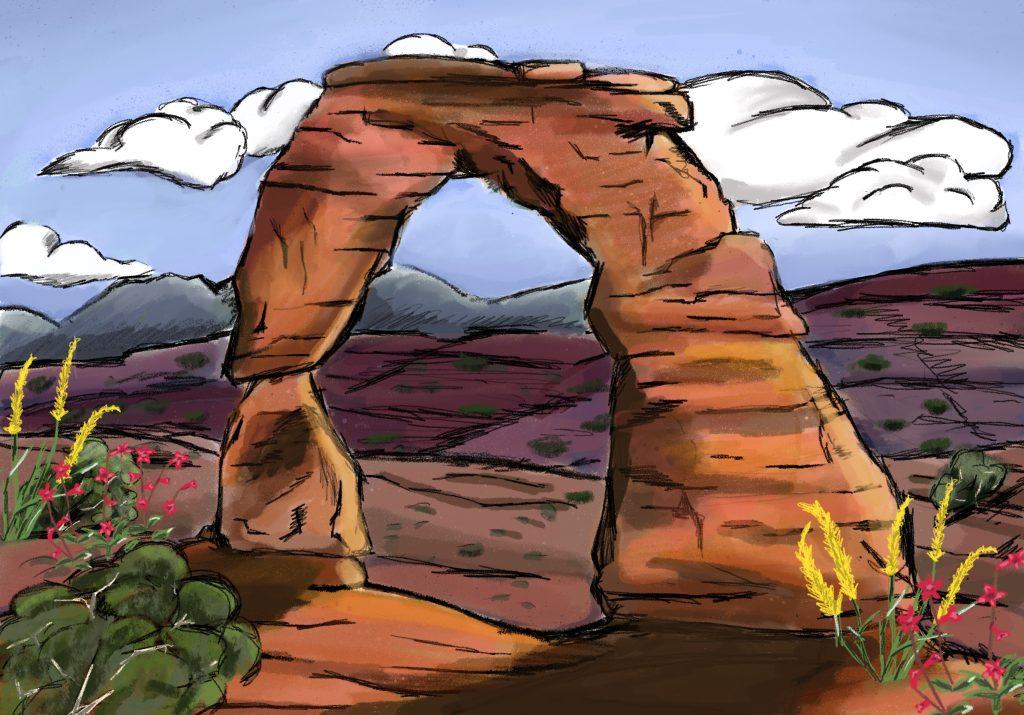
Transparency Item: The Perspectives section of the Graphic is comprised of articles based on opinion. This is the opinion and perspective of the writer.
If one seeks excitement, they shall find it in New York. If it is adventure, California. But if one pursues enlightenment, it lies waiting in Utah’s desert.
The names of cities and structures in Utah are of the Old Testament variety: Moab, Enoch and Zion, The Devil’s Garden and The Fiery Furnace.
In seemingly cloudless skies, lightning ripples across in surreal fashion. To the common traveler, weather on the interstate does not function according to natural laws but rather divine will.
Even the plants radiate an energy — a vibration. A loosely mythical sense in my mind cannot help but acknowledge that the plants have a consciousness. A particularly judgmental Sand Sage once gave me a glare after I played too loud a song. Their California cousins, the White Sage, are far more polite, with sweet-smelling shoots that hum in the wind and love music of all kinds.
This is the last expanse. The last bit of Mother Nature that has not been tamed or flooded or damned.
This feels like God’s country in the most vivid use of the term.
There is a road that passes through this portion of the state: Interstate 70. It starts at the edge of Green River, which is more a collection of gas stations than a town. Outside Green River, there is a sign that reads: “No services next 106 miles.”
Driving West, I-70 crosses the rocky barren of the Colorado plateau. In the distance, huge stone shelves hang over the horizon like a foreboding remnant of some long-forgotten ancient people.
South of I-70 is Arches National Park, where tourists in gym shoes organize lines to gather Instagrammable content at the Delicate Arch. Elsewhere in the park is the aforementioned Devil’s Garden. Hikers far enough on the trail will find a sign that reads: “Caution. Primitive trail. Difficult hiking.”
You can feel it even in your fragile machine of plastic and low-grade steel as it hurtles down at 85 miles per hour on and around the sweeping turns of I-70. Up and down anticlines that have witnessed millions of years of mortality. There are no trees that bear fruit — those who witnessed Genesis know what happens when they offer humankind an apple.
Your tongue sticks to the roof of your mouth when the window is down because there is no moisture in this air. Even with companions in the car, nothing seems to drown out the deafening silence.
Finally, it creeps up on you — the sense that those layers of engineered plastic that make up your car are the only thing that lay in between you and sheer, utter nothingness.
I’ve done this drive twice. Once with two old friends, once by myself. When I was with friends, they drove, and I slept through it. When I was alone, I felt as if I was dreaming.
Then, the climbing is done. I-70 crosses over the Tushar Mountain, reaching its terminus. Behind: a vast, gaping canyon. In front is Interstate 15, running North-South. North is Salt Lake City andski resorts. South is Zion National Park and the beginnings of the Mojave Desert.
There is greenery now and towns whose billboards assure they are a viable destination for travelers — Beaver, Utah is the most notorious culprit. But the greenery is of the fraught, arid kind, and the towns are specks on the seemingly ethereal horizon.
At the Southwest edge of Utah, I-15 passes the outskirts of Zion National Park. I stayed in Zion for two nights in a campsite on the Northern edge of the park.
Elevation at the Northern edge of Zion is almost 8,000 feet above sea level, according to the National Park Service. It’s the kind of elevation that wakes the ill-adjusted — such as myself — up in the middle of the night, gasping for air that is too thin. The hills and rock formations are notable in the sense that they bear a striking resemblance to dragons that have settled down for a millennia-long rest.
Beyond Zion, I-15 bleeds into the Northern corner of Arizona and her great canyons and winding roads. Beyond that lies Nevada and the Mojave.
Las Vegas’ neon signs are far removed in geography from the midsummer’s dream of the barren land that is Utah. And yet, even beyond Nevada, on California’s coast, if one listens quite carefully, one may still hear a rather polite White Sage preaching the word of God’s country.
_________________________________
Follow the Graphic on Twitter @PeppGraphic
Contact Max Pohlenz via email maximilian.pohlenz@pepperdine.edu
